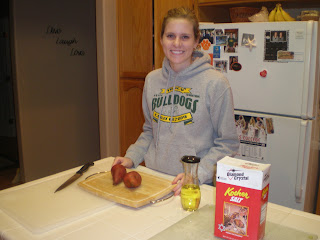Grilling is a popular aspect of American culture that flourished after World War II when the Weber Metal Works created the affordable Weber Grill. The barbeque is thought to have originated from the 17th century West Indian Island of Hispaniola. The native Arawakan Indians had a method of erecting a frame of wooden sticks over a fire in order to dry meat. In their language of Taino, they called it a barbacoa which Spanish explorers borrowed and eventually it transformed into what we know as the barbeque. Today, there are two main types of barbeque grills, propane and charcoal. Propane grills have an easy start up and are mainly used to quick foods fast. Propane burns around 1700 degrees Celsius, and the heat dissipates to the grill at about 340 degrees Celsius. Charcoal on the other hand, takes longer to prep and create a longer hotter cooking environment and thus increases the amount of Maillard reactions that occur. The charcoal creates a heat source with a high amount of thermal radiation which allows the charcoal grill temperature to be about 450 degrees Celsius.
This recipe will demonstrate the Maillard reaction using a propane grill and yams. A Maillard reaction is a chemical reaction of a carbohydrate molecule and an amino acid. A brown coloration and full, intense flavor result. Different than a caramelization, Maillard flavors tend to be more complex due to the addition of nitrogen and sulfur atoms from the amino acids to the mix of carbon, hydrogen, and oxygen. This results in the new aromatic dimensions such as pyridines, pyrazines, thiophenes, thiazoles, pyrroles, and oxazoles which contribute to a range of flavors.
When starchy vegetables such as potatoes experience high heat the starch begin to gelatinize. Gelatinized is characterized as swelling and becoming thicker in form. Starches exist as semicrystalline structures that can only be partially digested by the human body. When starches undergo high heat, they begin to melt, adsorb water, swell and convert to a form that is readily broken down by the digestive system. The starch will gelatinize depending on the type, length of time at temperature, amount of moisture in the environment, and processing conditions. Starches typically gelatinize in the temperature range of about 92-99 degrees Celsius, although it may vary depending on environment conditions.
This recipe shows the use of a propane grill to create a Maillard reaction that occurs in yams to produce pyrazines.
Materials:
2 yams
1/4 cup olive oil
1 pinch of sea salt
1 large bowl
1 pair of tongs
1 propane grill
Methods:
1. Slice yams into wedges.
2. Mix with olive oil and sea salt.
3. Place on grill for 10 minutes, flip, and grill for another ten minutes until tender.
4. Remove from grill and serve while hot.
Results:
1. Cut yams into wedges. Yams were very difficult to slice. Yams were very hard and little texture or aroma.
2. Mix with olive oil and sea salt. Olive oil added a shiny coat to outside of the yams. Yams are still very solid with addition of olive and sea salt.
3. Place on grill for 10 minutes, flip, and place on grill for another 10 minutes. The yams began to shrivel and create an aroma. They began to turn brown upon continual cooking.
4. Remove and serve while hot. The yams acquired black grill marks from the barbeque and were much softer in texture. They were able to be chewed very easily and had a sweet pleasant aroma.
Discussion:
The purpose of this recipe was to use a propane grill to create a Maillard reaction in yams to produce pyrazines. The recipe produced soft and flavored yams. The olive oil and salt added extra flavor and juiciness and a full taste of yams. The flavors and aromas were also created through the use of the high intensity of the grill. The Maillard reaction was successful and produced pyrazines. The carbohydrate and amino acid formed an unstable intermediate creating a new taste. This recipe was very easy and created edible yams quickly. The propane grill had a quick prep time and cooked the yams thoroughly and evenly. Next time, I would remove the smaller cut yams sooner on the grill so there would be less burn marks. The yams also continued to cook as they were removed from the grill due to their exposure of high heat. I would also try and cut the yams smaller in order to cook faster. The thicker cut of the yam, the harder it was determine when it was throughly cooked.
Compared to the previous recipe, vegetables cook very similar to yams. The grill produced a Maillard reaction in both recipies, but they both produced a slightly different aroma and texture. Based on these recipes and relationship is formed between the size of the food and how fast the food can be cooked. The larger the cut of the food, the longer it takes to cook.
Next time I try the recipe, I would experiment with different varieties of potatoes and starchy vegetables to determine the changes they undergo under high heat. I would also experiment with cooking with different increments of time to further analyze the Maillard reaction that the yam undergoes.
Citations:
Potter, Jeff. Cooking for Geeks. Sebastopol: O'Reilly, 2010. Print.





No comments:
Post a Comment